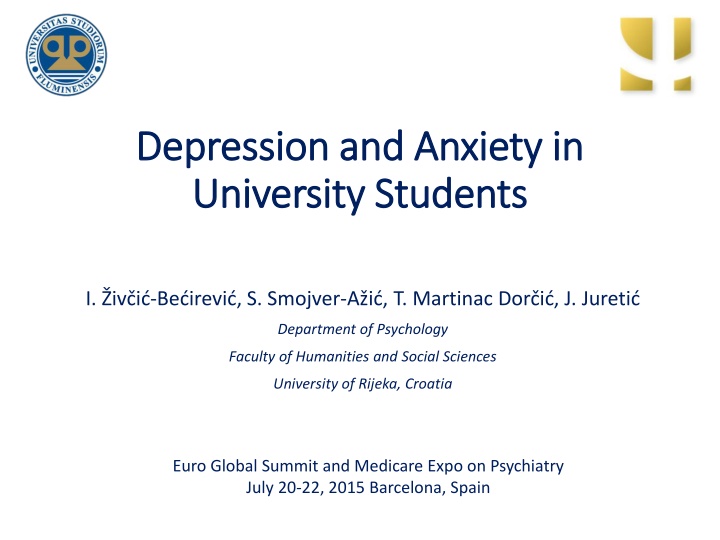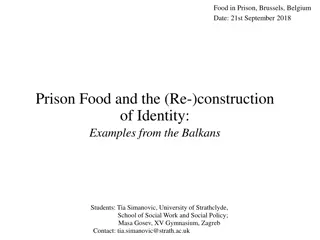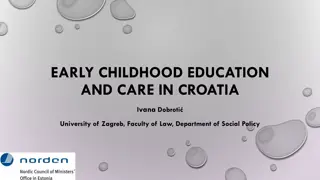
Mental Health Challenges in University Students
Explore the prevalence of psychological issues among college students, especially anxiety and depression. Learn about research findings, intervention programs, and the need for increased support for the vulnerable student population.
Download Presentation

Please find below an Image/Link to download the presentation.
The content on the website is provided AS IS for your information and personal use only. It may not be sold, licensed, or shared on other websites without obtaining consent from the author. If you encounter any issues during the download, it is possible that the publisher has removed the file from their server.
You are allowed to download the files provided on this website for personal or commercial use, subject to the condition that they are used lawfully. All files are the property of their respective owners.
The content on the website is provided AS IS for your information and personal use only. It may not be sold, licensed, or shared on other websites without obtaining consent from the author.
E N D
Presentation Transcript
Depression Depression and University University Students and Anxiety Anxiety in in Students I. iv i -Be irevi , S. Smojver-A i , T. Martinac Dor i , J. Jureti Department of Psychology Faculty of Humanities and Social Sciences University of Rijeka, Croatia Euro Global Summit and Medicare Expo on Psychiatry July 20-22, 2015 Barcelona, Spain
Outline Outline Mental health of university students The main results of our longitudinal research project Implications for the preventive and intervention programs Evaluation of the interventions conducted in our university counseling center
College students College students - - vulnerable population vulnerable population The age with the highest prevalence of psychological problems (16-24 years) Data from Australian universities show that students have more anxiety and depressive symptoms comparing to non-students of the same age (Stallman, 2008) 15% of university students in Croatia report some psychological or medical problems (Eurostudent, 2011)
Psychological problems in college students Psychological problems in college students Research on youth mental health indicates high prevalence of psychological problems among students across universities, mostly symptoms of stress, anxiety and depression The number of students with different psychological problems is increasing in the last two decades Depression rates have doubled and suicidality rates tripled in 10 years (Russis & Wells, 2008), with increase number of students using psychopharmacs from 11% to 24%. Suicide is the 2ndreason for death among university students and the 3rdin general population of the same age
Problems for which students Problems for which students seek in our in our University University C Counseling experiences experiences from from the seek help Center - - 17 years years help ounseling Center the last last 17 academic problems 15% 29% 5% interpersonal problems 14% anxiety 19% 18% depression stress/trauma other N=1300
The The main goals main goals of our longitudinal project of our longitudinal project To determine the prevalence of psychological problems among students at the beginning of college To track the changes in their adjustment during 3 years of their studying To investigate the role of cognitive and behavioral factors that contribute to students psychological adjustment and their academic achievement
Sample Sample male 40% Representative sample of 492 (20 %) freshmen at University in Rijeka female 60% Age 18-23 years (M=19) Moved out of home 55% Live with parents 45%
Procedure Procedure Academic achievement 3 measurements during 3 years VI. Psychological adjustment: Depression (BDI) Anxiety (BAI) V. IV. Fear of failure Fear of disappointing parents Lack of interest Positive thoughts III. II. Cognitive factors (ATs, beliefs about personal control, abilities and effort) I. Behavioral factors (learning & time menagement skills) Semester
Results Results
Prevalence Prevalence of depressive of depressive and symptoms symptoms when whenstarting and anxiety anxiety college starting college Depression Anxiety minimal mild 2% moderate 5% severe 4% 16% 14% 48% 34% 77% 7% report suicidal thoughts
The changes in psychological problems among college students during 3-years follow-up Results Results
Change Change in in average anxiety anxiety symptoms Depression (BDI) average depressi depressive symptoms ve and and Anxiety (BAI) 16 16 15 15 14 14 p<.01 13 13 12 12 male 11 11 p<.05 female 10 10 9 9 8 8 7 7 6 6 5 5 1st year 2nd year 3rd year 1st year 2nd year 3rd year p<.001 3rd< 1st, 2nd
Prevalence Prevalence of depressive of depressive and symptoms symptoms after after 3 3 years and anxiety anxiety years at at college college Depression Anxiety minimal mild 3% 4% moderate 3% severe 11% 14% 23% 63% 79% 3.5% report suicidal thughts
Results Results Changes on the individual level
Groups of students according to the Groups of students according to the changes in depressive symptoms changes in depressive symptoms 1styear 2ndyear change % non-depressed depressed 10 depressed non-depressed 15 non-depressed non-depressed 62 depressed depressed 13 nondepressed < cut off depressed > cut off
Differences between students who have developed Differences between students who have developed and and who did who didn n t develop depressive symptoms t develop depressive symptoms Depressed at 2ndyear (14%) More negative ATs (fear of failure & fear of disappointing parents) Less positive ATs Believe they have less control over their achievement Do not believe that their abilities and effort can contribute to their success The same number of stress events Non-depressed (at 1styear) Equal learning skills Non-depressed (at 2ndyear)
Groups of students according to the Groups of students according to the changes in anxiety symptoms changes in anxiety symptoms 1styear 2ndyear change % non-anxious anxious 16 anxious non-anxious 8 non-anxious non-anxious 29 anxious anxious 47 non-anxious < cut off anxious > cut off
Differences between students who have developed Differences between students who have developed and and who did who didn n t develop t develop anxiety symptoms anxiety symptoms Anxious at 2ndyear (36%) More negative ATs (fear of failure, fear of disappoining parents, lack of interest) Believe less that their abilities can contribute to their success The same number of stress events Non-anxious (at 1styear) Equal learning skills Non-anxious (at 2ndyear)
Results Results Effects of anxiety and depression on academic achievement
Anxiety and Anxiety and depression academic academic efficacy depression in in regard efficacy regard to to No correlation with GPA p<.001 20 p<.001 15 succesful failing 10 dropped out 5 0 BDI BAI Students who dropped out of school have higher levels of anxiety and depression at the 2ndyear comparing to successful students and those who fail, but who continue their study.
Conclusions Conclusions of of our our research research More students experience anxiety than depressive symptoms the average BAI result above the cut-off Anxiety is more pronounuced at the beginning of college (more than 50% of students are anxious at the 1stsemester) Even if students are not depressed in average, 23% of them have BDI results above cut-off Depressive and anxiety symptoms are not related to students academic achievement (GPA), but they increase the risk for dropping out of school Cognitive factors have more significant role then behavioral factors in the increase of anxiety and depressive symptoms
Negative depressive loop Negative depressive loop Academic failure Underachie- vement, Depressive symptoms low mood Poor concentration, hopelessness, more NATs, negative beliefs Low motivation; giving up from studying
Implication Implications s Importance of early detection of students with signs of depression, anxiety or academic problems Development of preventive and intervention programs
What we have already done What we have already done
E Early arly detectio detection of students with psychological problems n of students with psychological problems on-line questionnaire feedback with personal results recommendation Psychoeducation (self-help materials on the website) Contact counseling center
Individual and group CBT focused on: Individual and group CBT focused on: Cognitive interventions Realistic perception of control Coping with NATs Restructuring and reinforcing personal beliefs about abilities and effort Academic performance Behavioral interventions Improvement of self-control Reinforcement of personal efforts in academic work
Evalu Evalua ation of the individual treatment tion of the individual treatment before treatment after treatment N=130 21.09 25 18.27 20 15 7.93 10 4.58 5 0 BDI-II BAI Significant decrease (p< .001)
Evaluation Evaluation of of the individual individual level the treatment treatment on level (RCSC (RCSC method on the the method) ) improvement 28% recovery 64% no change 6% worsening 2%
Thank you! This study is supported by University of Rijeka (project No. 13.04.1.3.15)






















